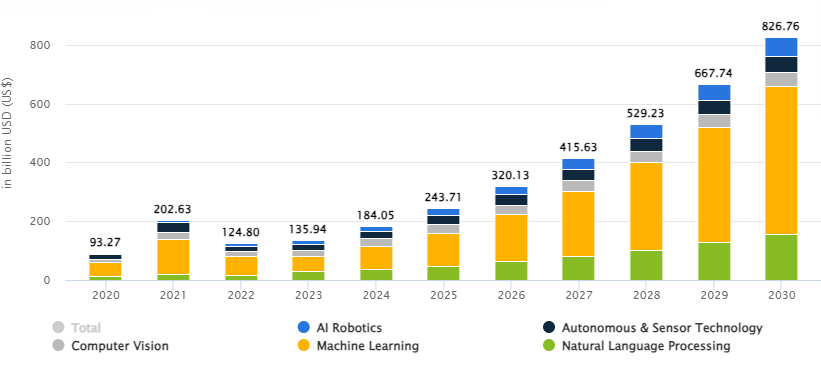Recommended Global EEE & Engineering Webinars & Conferences
Europe & UK
Asia Pacific & Middle East
Canada
ARTIFICIAL INTELLIGENCE-2024
- About Conference
- Sessions and Tracks
- Why To Attend?
- Benifits of Participation
- Market Analysis
- Visa Trip Advisor
About Conference
You're invited to join us at the 5th International Congress on AI and Machine Learning, happening in Paris, France on October 14-15, 2024. Our theme revolves around "Unleashing the power of data through AI and Machine Learning."
Artificial Intelligence (AI) is the discipline dedicated to crafting intelligent machines capable of emulating human behavior and undertaking tasks typically reliant on human intelligence. It encompasses a diverse array of methodologies and strategies aimed at empowering computers to perceive, reason, learn, and interact intelligently within their surroundings. Machine Learning (ML), a subset of AI, centers on algorithms and statistical models enabling computers to learn from data and refine their performance on particular tasks without direct programming. The synergy of AI and ML is propelling ground breaking progress across sectors, ranging from personalized online shopping recommendations to the advancement of autonomous vehicles and the transformation of healthcare via predictive analytics.
Sessions and Tracks
Track 01: Deep Learning
Deep learning has emerged as a revolutionary approach to machine learning, drawing inspiration from the structure and function of the human brain. By leveraging artificial neural networks with multiple layers, deep learning algorithms have unlocked unprecedented capabilities in various domains.
Track 02: Generative AI
Generative AI creates new data based on learned patterns. It's used for generating diverse content like images, text, and music. While enabling creative applications, it also raises concerns regarding authenticity and ethical use. Responsible development and oversight are essential for its positive integration into various domains.
Track 03: Neural Networks
Neural networks are computational models inspired by the structure and functioning of the human brain. They consist of interconnected nodes, or neurons, organized into layers, and are capable of learning complex patterns and relationships from data.
Track 04: Computer Vision
Computer vision is a field of artificial intelligence that enables computers to interpret and understand visual information from the real world. It encompasses techniques for acquiring, processing, analyzing, and interpreting digital images and videos.
Track 05: Reinforcement Learning
Reinforcement learning (RL) is a branch of machine learning concerned with training agents to make sequential decisions by interacting with an environment. RL algorithms aim to maximize cumulative rewards over time by discovering optimal strategies, known as policies, for achieving specific goals.
Track 06: Data Science
Data science is an interdisciplinary field that uses scientific methods, algorithms, and systems to extract insights and knowledge from structured and unstructured data. Data scientists employ techniques such as data mining, machine learning, and predictive analytics to uncover patterns, trends, and relationships in data, enabling data-driven decision-making and solving real-world problems across various domains.
Track 07: Cyber Security
Cybersecurity is the practice of protecting computer systems, networks, and data from unauthorized access, attacks, and damage. It encompasses technologies, processes, and practices designed to safeguard digital assets and mitigate the risks posed by cyber threats. Key aspects include network security, endpoint security, encryption, access control, threat detection, and incident response. With the increasing reliance on digital infrastructure, cybersecurity is crucial for ensuring the confidentiality, integrity, and availability of information, as well as maintaining trust and confidence in digital systems.
Track 08: AI Algorithms
AI algorithms are computational procedures designed to enable artificial intelligence systems to perform specific tasks or solve particular problems. These algorithms form the backbone of AI applications, enabling machines to learn from data, make decisions, and exhibit intelligent behavior.
Track 09: Big Data and Data Mining
Big data refers to large and complex datasets that exceed the capacity of traditional data processing systems to capture, store, manage, and analyze within a reasonable timeframe. Big data is characterized by the volume, velocity, variety, and veracity of data.
Data mining is the process of discovering patterns, trends, correlations, and insights from large datasets using statistical, machine learning, and data visualization techniques. Data mining helps extract actionable knowledge from data to support decision-making and predictive modeling.
Track 10: Predictive Analytics
Predictive analytics is the practice of extracting insights from data to predict future trends, behaviors, and outcomes. It involves analyzing historical data, identifying patterns and relationships, and using this information to make informed predictions about future events.
Track 11: Data Preprocessing
Data preprocessing involves cleaning, transforming, and organizing raw data for analysis. Tasks include handling missing values, removing duplicates, scaling features, and encoding categorical variables. This crucial step enhances data quality and reduces noise, improving the performance of machine learning models. Effective preprocessing ensures reliable insights and predictions.
Track 12: Robotics and Chatbots
Robotics involves the design, construction, operation, and use of robots to perform tasks traditionally done by humans or to automate repetitive tasks in various industries. Robots are programmable machines equipped with sensors, actuators, and control systems that enable them to interact with the physical world and perform specific functions autonomously or under human supervision.
Track 13: Artificial Neural Networks
Artificial Neural Networks (ANNs) are computational models inspired by the structure and functioning of the human brain's neural networks. ANNs consist of interconnected nodes, or artificial neurons, organized into layers. Each neuron receives input signals, performs a computation, and generates an output signal that is passed to subsequent neurons.
Track 14: Convolutional Neural Networks
Convolutional Neural Networks (CNNs) are a class of deep learning models specifically designed for processing structured grid data such as images. They have gained immense popularity and achieved remarkable success in various computer vision tasks, including image classification, object detection, and image segmentation.
Track 15: Recurrent Neural Networks
They utilize recurrent connections to maintain memory of past inputs, enabling them to capture temporal dependencies in data. RNNs are widely used in natural language processing, time series prediction, and speech recognition tasks. They consist of input, output, and recurrent layers, with hidden states dynamically updated at each time step. Training RNNs involves adjusting weights through backpropagation to minimize prediction errors over sequential data.Top of Form
Track 16: Transfer Learning and Ensemble Learning
Transfer Learning: Transfer Learning is a machine learning technique where a model trained on one task is reused or adapted for a different but related task. It leverages knowledge learned from a source domain to improve performance on a target domain with limited data, saving time and resources.
Ensemble Learning: Ensemble Learning is a machine learning approach where multiple models are trained to solve the same problem and their predictions are combined to make a final prediction. It often results in better performance than individual models by leveraging diverse perspectives and reducing overfitting.
Track 17: Bayesian Networks and Heuristics
Bayesian Networks are graphical models depicting variable relationships via directed acyclic graphs and conditional probabilities. They facilitate reasoning under uncertainty, predictive analytics, and modeling intricate systems by capturing causal connections.
Heuristics, conversely, are problem-solving methods favoring speed and practicality over perfection. Utilizing rules of thumb or shortcuts, they efficiently address complex issues where exhaustive search or precise calculations are infeasible, commonly found in artificial intelligence, optimization, and decision-making tasks.
Track 18: AI Infra, Tools & Applications
AI infrastructure refers to the hardware and software components required to support artificial intelligence (AI) and machine learning (ML) workloads. This includes computational resources such as servers, GPUs, TPUs, and cloud computing platforms, as well as storage systems, networking infrastructure, and specialized AI accelerators. AI infrastructure is designed to provide scalability, performance, and efficiency for training and inference tasks, enabling organizations to process large volumes of data and deploy AI models at scale.
Track 19: Cloud Automation
Cloud automation refers to the use of software and technologies to automate the provisioning, management, monitoring, and orchestration of cloud infrastructure and services. It enables organizations to streamline and optimize their cloud operations, improve efficiency, reduce manual intervention, and accelerate the delivery of IT resources and applications.
Track 20: AI Graphics & 3D-Printing
AI Graphics refers to the integration of artificial intelligence techniques into graphics rendering and manipulation processes. It involves using AI algorithms to enhance various aspects of computer graphics, including image synthesis, image editing, animation, and virtual reality (VR). AI techniques such as deep learning, generative adversarial networks (GANs), and reinforcement learning are applied to tasks such as image inpainting, style transfer, super-resolution, and content generation in graphics applications.
Why To Attend?
Stay Updated: Keep abreast of the latest trends, advancements, and innovations in AI and machine learning. These fields evolve rapidly, and conferences provide a platform to learn about cutting-edge technologies and techniques.
Networking Opportunities: Connect with experts, researchers, practitioners, and enthusiasts in the field. Networking can lead to collaborations, partnerships, and knowledge exchange, enriching your understanding and opening up new opportunities.
Professional Development: Enhance your skills and knowledge through workshops, tutorials, and keynote sessions conducted by industry leaders and academic experts. Gain insights into best practices, case studies, and real-world applications.
Explore Career Opportunities: Discover job openings, internships, and research positions in AI and machine learning. Many conferences host career fairs and recruiting events where you can interact with potential employers and showcase your expertise.
Visibility and Recognition: Present your research, projects, or ideas at poster sessions, paper presentations, or workshops. Conferences provide a platform to showcase your work to a diverse audience, receive feedback, and gain recognition within the AI and machine learning community.
Benifits of Participation
Benefits of Participation- Speaker
- Worldwide acknowledgment of Researcher’s profile
- Make Lasting connections at Networking and Social Events
- An opportunity to give One-page advertisement in abstract book and flyers distribution which eventually gets 1 Million views and add great value to your research profile
- Learn beyond your field of interest, a change to know more about the new topics and research apart from your core subject from ARTIFICIAL INTELLIGENCE.
- We provide unique convergence of Networking, Learning and Fun into a single package
Benefits of Participation- Delegate
- Professional Development –Uplift the knowledge and skills
- Conference attendance inspires, rejuvenates, and energizes delegates
- Your participation at our conference will be helpful for a new approach and ideology that can be utilized for the extending the outcome of companies or industries.
- Opportunities to meet through online webinar for ARTIFICIAL INTELLIGENCE researchers and experts of same field and share new ideas
Benefit of Participation- Sponsor
- Exposure to the international atmosphere will increase the odds of getting new business
- Opportunity to showcase the new technology, new products of your company, or the service your industry to a broad international participant.
- World’s No. 1 platform to show case ARTIFICIAL INTELLIGENCE products.
- Increase business by lead generation through our conference participants.
- ARTIFICIAL INTELLIGENCE conferences create opportunities for greater focus and reflection that could help you take your business to the next level.
- Benchmarking key strategies for business and moving it forward
- Real Benefits in New business-Many Organizations make deals and sign contracts at our ARTIFICIAL INTELLIGENCE.
Benefit of Association for Collaborators
- No one in the world have this huge visitor towards ARTIFICIAL INTELLIGENCE, this is the best platform to showcase the society
- Create long-lasting relationships with the peers
- Promotional content and Logo of your Association at our conference banner, website and other proceedings, branding and marketing material will increase your subscribers/Members number by 40%.
- Our event visibility to your Organization page can give a great impact for your association in the Global Market forum.
- Your representatives can network with key conference delegates to update their knowledge and understanding of your organization and services.
- Details will be incorporated with ARTIFICIAL INTELLIGENCE promotional materials like flyers, brochure, pamphlets, program which will be distributed to Hospitals, Universities, Society and Researchers
Market Analysis
KEY MARKET INSIGHTS
Visa Trip Advisor
Planning a trip to Paris, France? Attend our Meeting!
Issue with VISA?
To support participants in their Visa Application Process, we provide VISA support documents as follows:
1. Official Letter of Invitation
2. Official Letter of Abstract Acceptance
3. Receipt of Payment
Points to note:
- Visa Letter (official letter of invitation) will be issued only after successful registration and payment for the conference.
- Visa Letters can be issued only for the individual accepted to attend the conference.
- Please contact the Program Manager – James Atlas,via jamesatlas18@gmail.com to arrange for a Visa Letter.
Kindly provide us with the following information for Visa Letters:
- Your name as it appears on your passport
- Passport Scan Copy (passport number and date of birth)
- Abstract Acceptance letter
Payment Methods:
1. Payment Gateway - RAZORPAY
2. Bank-to-Bank transfer
Having trouble with registration?
Please contact Program Manager – James Atlas via jamesatlas18@gmail.com.The ARTIFICIAL INTELLIGENCE 2024, team will provide you with an INVOICE for the requested price, enabling you to make the Bank-to-Bank transfer.
To Collaborate Scientific Professionals around the World
Conference Date October 14-15, 2024
For Sponsors & Exhibitors
Speaker Opportunity
Useful Links
Supported By
All accepted abstracts will be published in respective Conference Series International Journals.
Abstracts will be provided with Digital Object Identifier by





